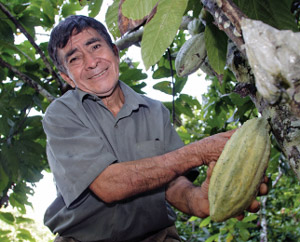Sweet cooperation: chocolate from farmer-owned co-ops
by Eli Penberthy
This article was originally published in October 2012

Chocolate’s good for the heart, skin and even mood — and here’s yet another reason to indulge: eating chocolate from responsible companies can support farmers in developing countries around the world.
Cacao cooperatives from Madagascar to Ecuador are empowering their member farmers, and the result couldn’t be sweeter. To celebrate National Co-op Month, we want to share the stories of the farmer- and employee-owned co-ops whose chocolates you’ll find at PCC.
The Kallari story
From bean to bar, most chocolate goes through many hands — from growers to chocolate makers, with several middlemen in between.
Not so with Kallari, one of the only farmer cooperatives in the world that harvests, makes, sells and retains all the profits from its line of certified organic chocolates. The indigenous cacao growers (850 of them) from the Kichwa Nation in the Amazon that make up the Kallari cooperative control every step of production.
The success of this business model demonstrates chocolate can be a powerful way for the cultures in the Amazon to save their rainforests. The co-op’s dark chocolate bars — now sold throughout the United States and Europe — have enabled the Kichwa people to make a living from a sustainable, renewable resource, without giving in to petroleum or logging pressures.
Other cacao cooperatives
PCC also sells chocolate from a worker-owned cooperative, Equal Exchange, which in turn sources its organic cacao from five farmer co-ops in Latin America. By working together within a co-op structure, these thousands of small-scale farmers can improve their productivity, crop quality and access to the world market in a way that would be impossible for any one of them to do on their own.
“A single small farmer can’t afford organic certification fees or build a quality control lab, but a co-operative can,” says Equal Exchange’s Rodney North. In fact, one Equal Exchange partner is the world’s leading producer of organic cacao, CONACADO, a co-op of 9,000 farmers in the Dominican Republic.
Other chocolate companies source cacao from cooperatives but are not cooperatives themselves.
Organic chocolate company Alter Eco, for instance, sources from the Fortaleza co-op in Ecuador and the Acopagro co-op in Peru. In 1994 a United Nations program enabled farmers who now make up Acopagro to begin replacing their illegal coca crops (used to make cocaine) with cocoa, freeing them from oppressive, dangerous relationships with drug traffickers. Acopagro now is thought to be one of the most successful farmer co-ops in South America.
The chocolate company Taza sources cacao from La Red Guaconejo, a cooperative of 225 small farmers located in mountain villages in the Dominican Republic.
The cacao beans for Madécasse chocolate come from the Ezaka Cooperative in a remote area of Madagascar. Madécasse’s founders installed equipment for fermenting and air drying the cacao, and created a training and bonus program for the co-op’s 32 farmers. It says it pays farmers more than fair trade prices. The chocolate also is made and packaged there for added benefit.
“Making the chocolate from bean to bar in Madagascar keeps jobs in the country and provides economic security,” says Madécasse founder, Brett Beach.
Like Alter Eco, Seattle’s Theo Chocolate also works with the Fortaleza co-op in Ecuador. It also sources from the CEPICAFE cooperative (Peru) and says the cooperative model is essential to farmers’ — and Theo’s — success.
According to Theo, CEPICAFE ensures its farmers understand the world market and their role in the international cocoa supply chain. This education is uncommon in many cocoa-producing regions and is valuable to the farmers.
Theo’s website says, “When cocoa farmers understand how cocoa is graded and purchased globally, it’s an important step toward their knowing exactly what they need to do to create higher-quality products, with greater market value, that will ultimately deliver greater returns on their hard work and dedication to the land they steward.”
Eli Penberthy is the Sound Consumer co-editor and a chocoholic.
